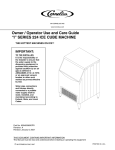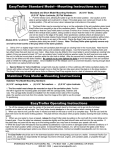Download SEPARATED AT BIRTH SEPARATED AT BIRTH
Transcript
Test Bench O Separated Separated at at Biirt rth h B April 1998 ver the years, I have had the opportunity to use a great many diagnostic tools at my garage, the Lusty Wrench. A few of these have been “loaners” from manufacturers who were looking for feedback and/or publicity. But along the way, I have also parted with a great deal of my hard-earned cash to acquire some of these tools for continuing use. A year or two ago, I formed a small consortium with two other small shops in the area, and we jointly purchased an Autodiagnos Multi-Tester plus along with a host of adapters and memory cassettes. Regular Import Service readers may recall that this tool has figured prominently in a number of recent articles. Because it can be plugged in between the car’s computer and its wiring harness, the Multi-Tester plus has proven to be a valuable tool for identifying faults in sensors or wiring. Its parallel connection also allows access to current data on each pin and has a built-in fault tracing function which can identify many types of failures. In many cases, of course, its greatest value has been in eliminating the fuel system from consideration as the possible source of some driveability problem. 29 Test Bench adapter. Two sets of Multitester plus parallel connection adapter harnesses and memory cassettes are shown at the bottom left corner of this page. With this connection it is possible to diagnose internal ECU failures, power feed problems, ground faults, and faults in sensors and wiring. For a thorough description of the parallel connection capabilities of the Multi-Tester plus, refer to the August 1995 issue of Import Service. On most 1989-95 Volvo models, it is also possible to troubleshoot using the parallel connection, while also utilizing the six-pin DLC to retrieve fault codes. This photo shows the diagnostic twins at work, Most 1995 and with both hooked up to the same car. Most Volvo later Volvos are dealer techs tape the ON/OFF switchbox and equipped with adapter to the bottom of the VST (or Multi-Tester a 16-pin data plus) body to make it easier to work with. link connector. By adding the home of the annual International Twins Festival, on my way to visit Volvo of Hudson. There, I met with Some ’96 and ’97 models experiVolvo Master Technician Dan Radford, who had enced problems with this system kindly agreed to give us a tour of the VST’s capabilsetting a DTC and illuminating ities and let us see how the Multi-Tester plus comthe MIL. The freeze-frame data pared to it. associated with the code showed Autodiagnos kindly lent us a set of cables and this problem happening at low memory cassettes that allowed our familiar Multiengine temperatures. The probTester plus not merely to emulate, but to actually lem was traced to the purge become the Volvo Scan Tool. It turns out that the valves sticking when first activated after a cold start, and a new Autodiagnos folks make both the VST and the part was introduced to correct the problem. Multi-Tester plus to the same specs and with the same internal circuitry. The differences are merely cosmetic. Twins? Some time ago, I heard via the grapevine that our Multi-Tester plus was not just what it appeared to be, but was, in fact, the identical twin of the Volvo Scan Tool, from which it had been separated at birth. I had also heard that the VST, as it is known, is the favored weapon of Volvo dealer techs everywhere. So it seemed appropriate that I should travel through Twinsburg, Ohio, Twins Make It More Exciting With the proper adapters and cassettes, the MultiTester plus can be used for diagnostic troubleshooting on Volvo cars in three different ways. They are: ➤ Parallel connection at the ECU for engine management systems such as LH-Jetronic 2.0-2.2, LHJetronic 2.4, Regina, and Motronic 1.8 for many Volvo models. ➤ A combination of connection at the ECU and the six-pin underhood diagnostic link connector (DLC) on 1989 and later model year Volvos for the systems noted above, plus Motronic 3.2. ➤ At the 16-pin OBD II console DLC for most 1995 and later Volvos with Motronic 4.3, 4.4, and Fenix 5.2 engine management systems. Each connection option has a unique set of characteristics. The parallel connection, which is available for most European makes, requires accessing the ECU wiring harness connector to install a double-sided 32 Volvo is currently having some problems with SAS valves not seating in the fully closed position due to a sticking diaphragm. If we had simply applied vacuum to the SAS control valve with a vacuum pump while the engine was running, we would have set a DTC in memory, but since we did it via the tester, we didn’t have to worry about that. April 1998 serial communications components, the Multi-Tester plus offers 100 percent dealer-level troubleshooting ability, as well as diagnostic trouble code (DTC) retrieval and reset capabilities. This set-up goes beyond the federallymandated requirements of OBD-II by offering bi-directional control, as well as access to climate control systems, instrument panels, and various body systems, such as sunroofs and power seats. We began our session at Volvo of Hudson with a brand-new ’98 S70—a 2.4 L, five-cylinder, 20-valve normally aspirated sedan. The OBD-II connector is located under a small access cover in the center console. We hooked up the tester and selected the appropriate model from the opening menu. Then we selected ENGINE and then MOTRONIC 4.4. Dan had already warmed the car up prior to pulling it into the bays, so we were able to go right to work. We decided to run a test of the EVAP system, accessing it from the DIAGNOSTIC CHECK menu. After a couple of minutes the tester announced that the test had been completed. Did this mean that the car had passed the test? No, explained Dan, we would have to exit back out to the DTC menu, then check to see whether there was a code. The absence of a code coupled with the message that the test was completed meant that the test had been passed. Otherwise there would be a DTC in current memory. We verified the absence of DTCs and returned to the functional test menu, whence we could check the secondary air system (SAS) by activating the SAS control valve. Many DTCs can be logged in pending memory without triggering the MIL. If a malfunction is detected in three consecutive drive cycles, the MIL will illuminate. If it fails to reappear in three drive cycles, it will be purged from memory. You can access the current status of pending and logged DTCs under the Read DTCs menu. After clearing that code and resetting adaptive memory, we unplugged an injector. Because this was a dead misfire, the PCM immediately set a cylinder-specific DTC and fired up the MIL. A portion of the freeze-frame data is displayed in this photo. The message “CNT.MIL OFF= 3” means the MIL will be extinguished if the fault referenced is not detected during the next three warm up and drive cycles. We decided to induce a few problems. First we unplugged and then reconnected the air flow sensor, setting DTC P0201. We were pleased to see that the tester readout showed the problem as intermittent. The MIL remained off, since the problem had not recurred and had not (yet) had a serious impact on emissions. After clearing that code and resetting adaptive memory, we unplugged an injector. Because this was a dead misfire, the PCM immediately set a cylinderspecific DTC and fired up the MIL. A portion of the freeze-frame data is displayed in this photo. Pushing the Left Arrow [<—] key while monitoring serial data adds a “parameter number” to the left margin of the readout. This parameter number corresponds to a specific numbered section of the appropriate vehicle service manual. For example, a line number of “10” refers to short-term fuel trim. The service manual notes the available range (01.992) and the normal value (oscillates around 1). The significance of variations from the norm are noted (e.g. values <1 indicate rich air/fuel mixture, values >1 indicate a lean mixture). There is also a brief explanation of the meaning and operating strategy underlying each parameter. I asked Dan to share a tech-tip with us. Here’s one of the stories he told us: Sometimes the diagnostics can throw you for a loop. On some late-model Volvos, proximity to the heat of the exhaust may cause the front O2 sensor’s insulation to melt. The air space between the filaments of the conductor and its insulation is the breathing tube for the O2 sensor. The melting closes off the supply of outside air upon which the sensor depends in order to generate an accurate reading of the difference in the O2 concentrations on each side of the sensor. Sensor voltage drops, since the O2 concentrations on each side of the sensor’s tip equalize. The PCM will respond by enriching the mixture. The rear O2 sensor will detect the fault The message “CNT.MIL OFF= 3” means and will trigger the MIL. The PCM will the MIL will be extinguished if the fault referenced is not detected during the default to a limp-home strategy. So far, next three warm up and drive cycles. so good. April 1998 33 Test Bench Replacing the front O2 sensor should fix the problem, but the MIL will illuminate and throw a DTC on your test drive because the high sulfur content accumulated in the converter confuses it into thinking that there is still a problem. The solution is about ten minutes of sustained driving at high RPM and moderate load, say maybe third gear on the freeway. Be sure to clear all the DTCs and the adaptive memory and perform another drive cycle to verify the fix before returning the car to your customer. This brings up another very important set of points. I don’t want to dwell on this, but it bears widespread distribution: a scan tool does not fix a car; a good technician does. When confronted with a driveability probThe Combi menu also provides a functional test of the instrument panel lem, follow this prescription: electronics, allowing silly readings like those in this photo. ❶ Verify the complaint. Be sure you understand what it is that your customer is experiencing. The ELECTRICAL menu allows troubleshooting ❷ Read, record, and clear all DTCs. Be sure to note the anti-theft system or the instrument panel, any freeze-frame data so that you can try to recreate referred to as the “Combi.” There are interesting the conditions under which the problem has previoptions available for the Combi, including resetting ously occurred. the default service intervals for vehicles used in ❸ Clear all adaptive memory. severe service, for example. You can also alter the ❹ Re-verify the condition. amount of fuel remaining in the tank when the “Low ❺ Re-check for DTCs. Fuel” lamp first illuminates. (Factory default for this ❻ Repair the underlying cause(s). parameter is 0.5 gal. You can increase it to as much ❼ Repeat steps 2-5. Your final test drive should as 2.5 gal. for those of your customers who might include low-speed, stop and go city driving and benefit from the change.) high-speed sustained cruise. A fifteen-minute loop The TRANSMISSION menu accesses shaft and is usually enough to allow most OBD-II monitors to turbine speeds, etc. Dan says he’s had virtually no activate. problems with the trannies or the control units on The number one complaint of motorists is having the newer Volvos he’s been servicing. You and I may to take the car back a second time for the same probneed all the info we can get a few years down the lem. Dan has raised his dealership’s service quality road. rating to the highest in the area by adhering faithfulThe BRAKES menu, of course, accesses the antily to this set of rules. lock system, DTCs, and data stream. Watch out when reading wheel speeds on a road test. Trees Other Functions seem to be inordinately attracted to the front of a car I mentioned that when equipped with the serial whose driver is looking elsewhere. There are also communications kit the Multi-Tester plus can interfunctional actuation face with numerous other systems in the car. The tests for the ABS main menu selections are SERVICE, ENGINE, ELECvalves. TRICAL, TRANSMISSION, BRAKES, and BODY. The BODY menu The first of these, SERVICE, is used to access and allows communicaextinguish the service required lamp or SRL. Unlike earlier models where the SRL could be extinguished by pushing a reset button or through manipulating the jumper at the six-pin With the serial communications underhood diagnostic socket, late model Volvos kit, you can use the Multi-Tester require a scan tool or a specialized reset tool plus to diagnose a bad power seat capable of a “handshake” with the PCM to reset switch, for example, by actuating the SRL. each seat motor in turn through In addition to the fuel control system, the ignithe test menu. tion system can also be entered through the tester under the ENGINE menu. 34 April 1998 tion with the seats, sunroof, and climate control systems. You can read high-side A/C pressures, for instance, which is a good thing as there is no high-side service port on most current models. We found a DTC in memory when we accessed the power seats on our test car. Apparently it is an artifact left over from the factory programming. It proved impossible to clear from memory, but, considering its content, we weren’t going to worry about it! With the serial communications kit, you can use the Multi-Tester plus to diagnose a bad power seat switch, for example, by actuating each seat motor in turn through the test menu. How To Get It If you want to get your hands on an Autodiagnos Multi-Tester plus, or the cartridges and adapter cables necessary to add serial communications capabilities, contact your local Autodiagnos distributor, telephone the Autodiagnos U.S. office at (330) 6681518, or Circle No. 201 on the Reader Service Card. Autodiagnos can provide you with information on any combination of adapters and cassettes for Volvo and other European cars, as well as serial communication components. To get the most out of the powertrain management diagnostic power of the Multi-Tester plus and the serial communications kit, you may want to purchase the following diagnostic reference material from Volvo: • TP 2310201 is the VST manual and covers serial communication and text read-out. • TP 32379/2 covers LH 3.2 and EZK systems. • TP 2301202 is the Motronic 4.3 reference. • TP 2318201 and TP 2327201 cover Motronic 4.4. • TP 2310201 covers the Volvo Scan Tool. This photo shows the VADIS console with one of the twins in attendance in the upper right. In the upper left is a built-in breakout box. Pre-configured screens and dedicated cables let VADIS communicate with the VST. The technician can measure a variety of signals using the built-in leads and pre-configured meter screens through the breakout box without ever reaching for his multimeter. Suffice it to say that, compared to the hurricane that is this new technology, most of the revolutions in automotive technology of the past thirty years will look as insignificant as the morning dew. We’ll be updating you later so you can survive the coming storm. ▲ —By Sam Bell Crystal Balls We asked Dan to tell us what might be coming from Volvo in the near future. He introduced us to VADIS, a PC-based, CD-ROM driven information system coupling diagnostic troubleshooting procedures, parts and service information, and built-in diagnostic equipment. The VADIS system at Dan’s shop has been sitting mostly dormant for several months awaiting both hardware and software fixes. Historically, Volvo’s new model training for technicians was accomplished in about a week’s worth of time. Dan tells us that the new model year introduction for 1999 models is shaping up to be about six times as long and will be spread over a period of several months. The biggest upcoming change will be the advent of a true multiplexing system throughout the car. April 1998 35



















